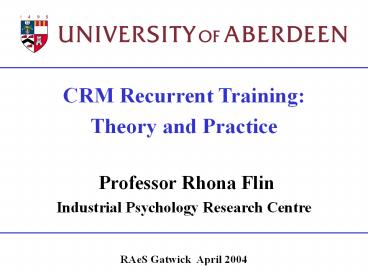CRM Recurrent Training: - PowerPoint PPT Presentation
Title:
CRM Recurrent Training:
Description:
CRM Recurrent Training: Theory and Practice Professor Rhona Flin Industrial Psychology Research Centre RAeS Gatwick April 2004 JAR-OPS / see CAA CAP 737 Recurrent CRM ... – PowerPoint PPT presentation
Number of Views:438
Avg rating:3.0/5.0
Title: CRM Recurrent Training:
1
- CRM Recurrent Training
- Theory and Practice
- Professor Rhona Flin
- Industrial Psychology Research Centre
- RAeS Gatwick April 2004
2
Clients include Agip, AKER Offshore (Norway),
AMEC, Amerada Hess, AMOCO, British Energy, BHP,
BP, Brown Root, Chevron, Civil Aviation
Authority, Coflexip Stena Offshore, Conoco
Phillips, Defence Evaluation and Research Agency
(DERA), EC (DGTREN), First Group, Halliburton,
Health Safety Executive, KBR, Kerr McGee,
National Power, NHS, Powergen, Royal College of
Surgeons, Salamis SGB, Schlumberger, SCPMDE,
Shell, Talisman, Texaco, Total Fina Elf,
Transocean Sedco Forex, UBS Warburg UK Nuclear
Imc.
3
JAR-OPS / see CAA CAP 737
- Recurrent CRM training should
- cover all major CRM topics, at least once
every three years - include case studies eg same operator or same
aircraft type - address operational needs
- be based on feedback from assessment of CRM
skills - See also Griffiths paper this conference
- -
- Cycle of CRM training.
4
Recurrent trainingLearning from other industries
5
Evidence Based Training
- Behavioural safety training (e.g. CRM) should be
designed and evaluated with the same attention to
evidence as technical training. - Repeat training needs analysis
- Track effectiveness
- Tailored to enhance CRM skills for changing
demands/ threats
6
Closing the Loop
- Ongoing diagnosis needs analysis
- Design and redesign
- 3. Evaluate impact (ROI)
7
Closing the Loop
Behaviour/ Safety Problem
Diagnosis/ Task Analysis
Design and test Intervention
8
Closing the Loop
Monitor Evaluate
Behaviour/ Safety Problem
Implement Intervention
Diagnosis/ Task Analysis
Design and test Intervention
9
A methodology for training design (adapted from
Goldstein Ford 2002, Salas 1999)
- Determine training requirements
- Identify operational requirements.
- Assess training needs.
- Identify existing competencies.
- Determine training objectives.
- Design training method and materials
- Determine content and training delivery method.
- Design scenarios and create opportunities for
practice. - Training evaluation
- 1. Design assessment measures.
- 2. Design and tailor tools for feedback.
- 3. Evaluate the effectiveness of the training.
10
Closing the Loop
- Diagnosis of CRM skills to be included in
recurrent training?
11
CRM Behaviours Diagnostic Techniques
- Task analysis / Cognitive Task Analysis
- Accident near-miss analysis (on non-technical
/human factors) - Crew interviews and surveys
- Flightdeck and simulator checks/ observations
- Confidential safety reporting systems
- Organisational - Safety climate surveys eg
Lufthansa safety survey see Nebb paper this
conference
12
Identifying CRM skills for an ever-changing
environment
- New aviation technology
- ATM changes e.g. free skies
- Demographic changes to pilot population
- Emerging threats eg suicidal terrorism
13
Closing the Loop
- 2. Design recurrent CRM training from identified
skill needs / changing context - i.e. Evidence-based training
14
CRM skill decay rate?
- Most skills will show some fade over time
depending on levels of practice and feedback so
what is best retraining interval? - Examples from operators, ½ day every year, 2 days
every 3 years - Irwin (1991) reported reduction in CRM attitudes
after one year - - recurrent training produced improvement
- Edkins (2002) Still few CRM longitudinal studies
15
Closing the Loop
- 3. Evaluate training
- What is the return on investment (ROI)?
16
CRM evaluation/ development
17
Training Evaluation Measures
- Participant feedback (course content and
delivery) - But has training transferred to worksite?
- Skill tests eg NOTECHS behavioural markers
- Interviews / questionnaires (attitudes,
behaviours) - On the job/ simulator observations
- Safety climate assessment
- Accident rates
18
CRM training beyond the cockpit
Maersk CRM for ships and rigs
Pre-CRM (1992) 1 Nautical casualty per 30 ship
years 6.5 LTIs per million exposure hours per
fleet Post-CRM (1996) 1 Nautical casualty per 90
ship years 3.7 LTIs per million exposure hours
per fleet (1998) Reduction of insurance premium
by 15 for fleet and offshore installations
19
Barriers to CRM evaluationUK Air Operators 2002
- LACK OF Time
- Resources
- Evaluation tools
- Expertise
- Management support
- OConnor, Flin, Fletcher, Hemsley (2002 HFAS)
20
Benefits of recurrent training
- Skill enhancement
- Improved skill fit for changing environment
- Feedback opportunity
21
Evidence Based Practice?
- Behavioural issues relating to safety should be
diagnosed, designed and evaluated with the same
attention to scientific knowledge as engineering
applications. - BUT
- Why let a few facts get in the way of a good
story
22
References
- Edkins (2002) Review of benefits of aviation HF
training. Human Factors and Aerospace Safety, 2,
201-216. - Goldstein Ford (2002) Training in
Organizations. Wadsworth. - Irwin (1991) Impact of initial and recurrent CRM
on attitudes. Sixth Int. Aviation
Psych.conference, Ohio. - OConnor, Flin, Fletcher Hemsley (2002)
Evaluation of the effectiveness of flightcrew CRM
training. Human Factors and Aerospace Safety, 2,
235-255. Also CAA research report.
23
Thank you
- r.flin_at_abdn.ac.uk
- www.abdn.ac.uk/iprc

